Do you drink tea?
If so, how much do you think about the pricing strategy behind the types of tea that you buy?
Do you have a budget in mind when choosing the right tea vendor for you?
Or perhaps your focus is on ethically sourced tea with numerous health benefits.
Whatever the reason, there’s an e-commerce store just waiting to sell you tea.
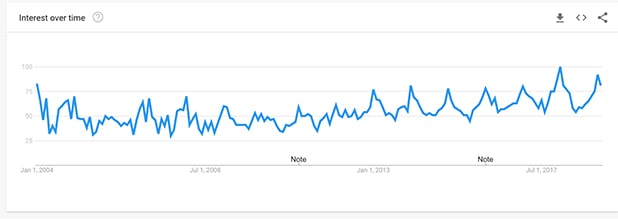
Over time, there’s been a steady increase in search interest for the phrase “herbal tea”.
Perhaps, not surprisingly, these peaks generally occur around January.
It makes sense, though. The start of a new year is usually when people are most likely to look for healthier alternatives to their current lifestyles.
In this post, we’re going to look at one particular tea company, Cup and Leaf. They’re a fairly new e-commerce business, and we’re going to dive into their pricing strategies.
That way, if you’re operating an e-commerce store in the food and drink industry (or plan to) you have some strategy ideas you can use.
Relate products to article
One thing Cup and Leaf do really well (that many e-commerce stores neglect to do) is to produce great content.
Cup and leaf rank for great key phrases like:
“Best oolong tea”
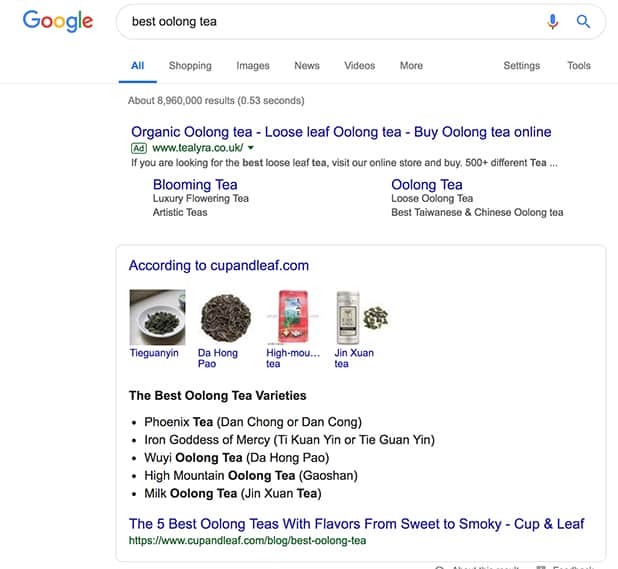
If you think about the search phrase “best oolong tea”, it’s a high-user-intent search.
There’s a good chance someone looking for the perfect Oolong tea is ready to make a purchase.
Now, if Cup and Leaf was just a blog, they’d be able to talk about the different types of Oolong tea’s and why they’re great.
But because Cup and leaf focus on creating great content to support their e-commerce store, they’re able to use their first-place ranking to increase sales potential.
Let’s look at how.
This blog post is, first and foremost, informative. This means, even if someone isn’t looking to buy tea, they’ll still take value from the article
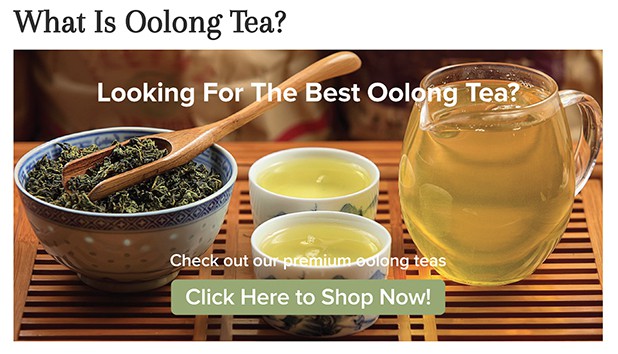
Second to that, though, throughout the article, there are links scattered through linking to product pages.
The main call to action header image at the top of the article is ideal for those ready to buy.

You’ll also notice that many of the links within the article point to specific Oolong tea products within their own store.
And finally, after reading the article (if you haven’t already clicked on any of the links) they include direct links to product pages of the Oolong tea’s mentioned in the article.

Relating your articles to your products, or your products to your articles is an effective way to:
- Increase your organic rankings on search engines
- Provide more value for your customers
- Improve the relevancy of your content
Discounts
It goes without saying, e-commerce stores can benefit from offering their customers and potential customers some sort of money off, or discounts.
This is especially true for newer e-commerce stores where they perhaps don’t have the same level of brand appeal compared to larger competitors.
Cup and leaf offer their customers 20% off a purchase.
What’s interesting, though is how they present this offer.
They use the same offer (20% off) in three different ways across their website.
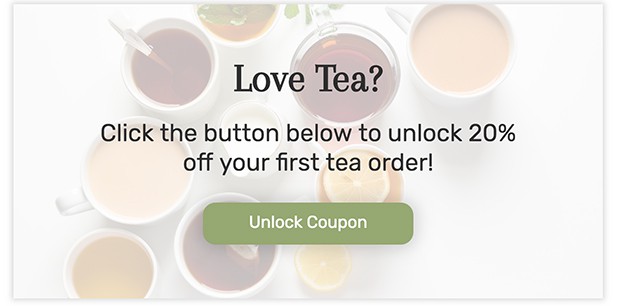
They offer 20% off as an ‘unlockable coupon’. This asset is featured on their blog post.
It’s effective to present it this way because there is less pressure to sign up.
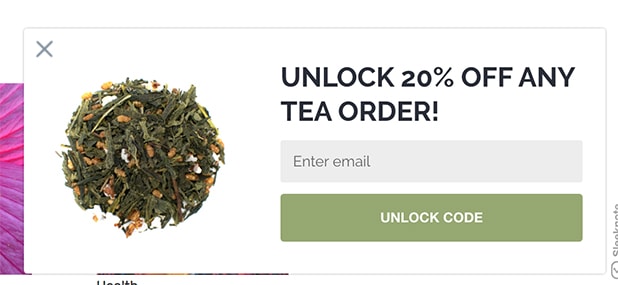
They also have an unobtrusive slider at the bottom right-hand side of the screen.
All you have to do here is enter your email address and you’ll have access to a 20% off discount code.

Finally, on their store homepage, the box above asks for an email address in exchange for 20% off.
The reason this discount strategy works so well is that because it removes pressure where pressure isn’t wanted and adds pressure where it’s accepted.
If you’re just browsing the blog, with no intention of buying – an intense “BUY NOW MONEY OFF” popup is just going to ruin the entire experience.
Likewise, if you hide your money off coupon on your actual store, fewer people will find and use it.
Whole pricing
There is continuous debate over the psychological benefit of .99 versus .00 pricing strategy. Numerous sources and studies talk of importance and benefit to sales you achieve when you price your products with a slight discount.
So 1.99 vs 2.00
But Cup and leaf don’t follow this strategy.

All their products follow a whole number system. The way their tea is sold is by weight.
Customers decide how much of each tea they’d like to purchase

Using whole numbers in this way makes it easier for customers to think about value.
If they’d used prices like 7.99 or 7.49, working out whether it was a better deal to go for the 2oz or 4oz would involve a complex sum that most customers wouldn’t want to work out.
The way they do it now, though, is simple.
2oz is $20.00
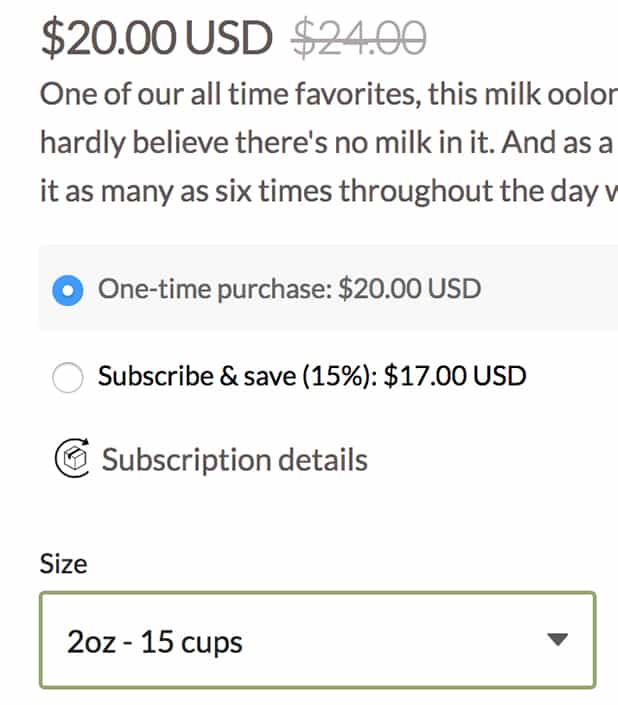
And 4oz is $40
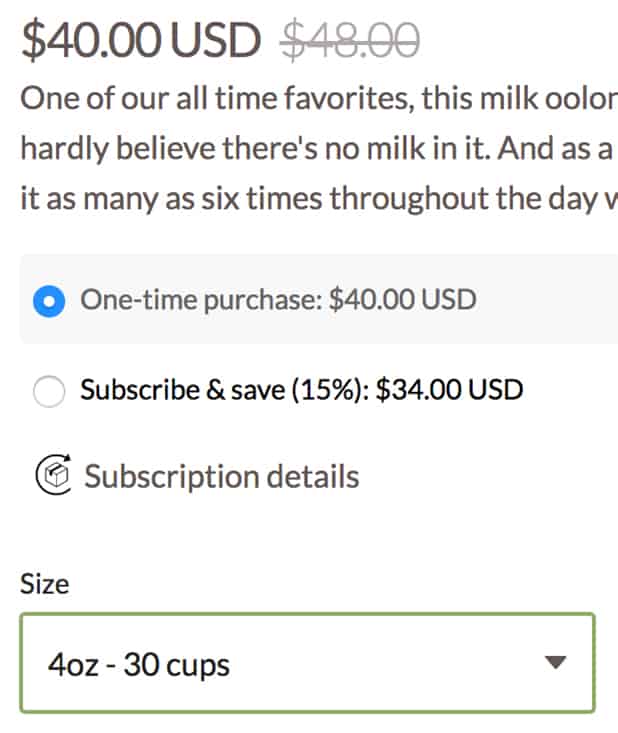
When you offer different prices for the same product, you need to make it easy for your customers to compare prices.
For example
If you had:
Small bag of tea: $1.00
Medium bag of tea: 1.23
Large bag of tea: $1.76
You’re not sure which bag of tea actually offers you the best value for money.
Subscription offers
For many businesses, a subscription-based model works well and for some, this is their entire business model.
However, even if you usually sell your products as individual items, you can still adopt and use a subscription model – you just need to make sure your products lend themselves to it.
Think about if you sold TVs. How often do you buy a new TV? Unless it breaks, probably not often.
Therefore it’d be a stupid idea to have a monthly TV subscription service.
Compare that, then, to how often you buy tea.
For the heavy tea drinkers, this could be a weekly purchase, but even for the less heavy tea drinkers, once a month seems like a reasonable time frame.
How much easier would your life be if you never had to think about purchasing your favorite tea again?
Imagine a world where every 15, 30 or 60 days a new batch of tea arrived at your door.

This is exactly what Cup and Leaf do.
They allow customers to decide what frequency they’d like their tea delivered, and when you choose a subscription offer you even save 15%.
This method is effective because tea is the type of product people buy again and again.
However, one caveat to note if you plan to incorporate a subscription model to your e-commerce business – it’s less likely to convert new customers.
After all, without prior knowledge or understanding of the quality you offer, why would anyone commit to a subscription?
Free Shipping
We’ve spoken heavily about the benefits of free shipping on our blog and the reason for this, is that it works.

Cup and leaf offer free shipping on any order over $25.
The reason this is a good number to choose is because of the “top-up” premise.
We look at a few of Cup and Leaf’s product price points, they all float around the $20 mark.
Let’s take this Chamomile Lemongrass tea as an example.
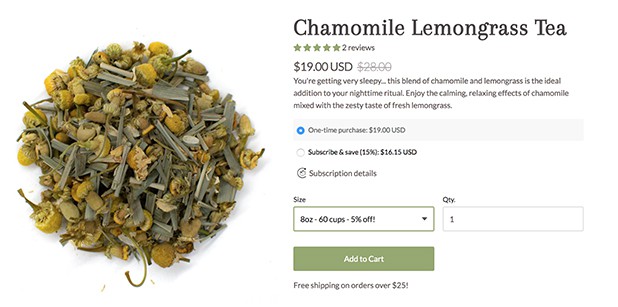
At $19.00 for 60 cups, it’s a steal!
But now factor in the shipping costs.
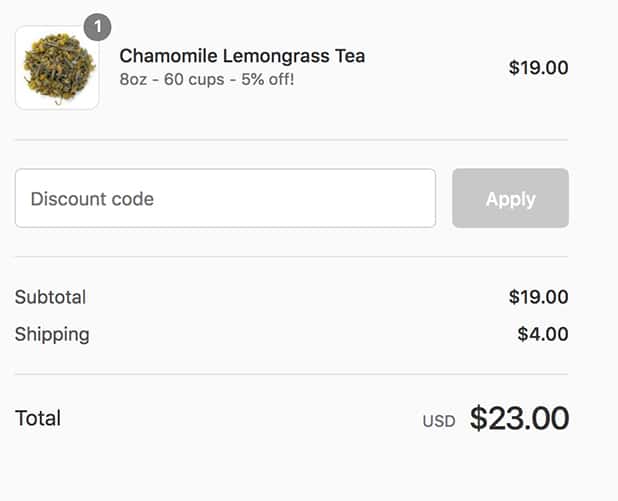
Would it not be a better idea to spend an additional $6 and get an extra item AND free shipping?

Now I can get the tea strainer and the tea for $25.00 + free shipping.
Wrapping up the e-commerce pricing teardown part 3
Whether you’re looking to start your own tea e-commerce business, or perhaps improve an existing one, we hope this post has given you some insight into the sorts of strategies beverage companies use to market and price their products.
If you have any questions about the post or want to suggest another industry teardown, leave a comment below.



Leave a Reply